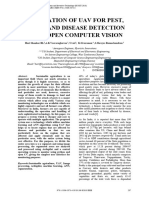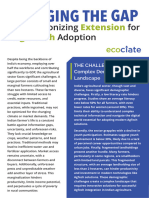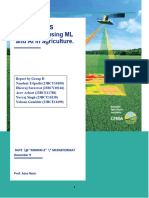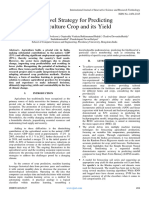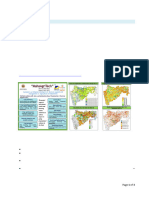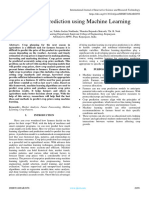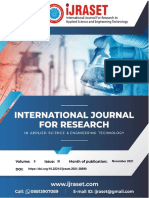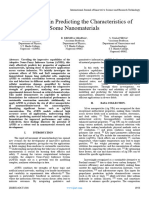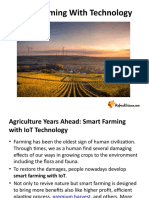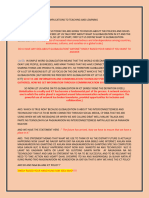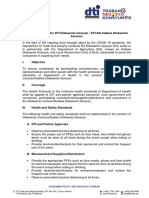Multi-Model Ensemble Approach For Soybean Crop Yield Estimation (Kharif-2023) in Latur District at Macroscale Level
Multi-Model Ensemble Approach For Soybean Crop Yield Estimation (Kharif-2023) in Latur District at Macroscale Level
Copyright:
Available Formats
Multi-Model Ensemble Approach For Soybean Crop Yield Estimation (Kharif-2023) in Latur District at Macroscale Level
Multi-Model Ensemble Approach For Soybean Crop Yield Estimation (Kharif-2023) in Latur District at Macroscale Level
Original Title
Copyright
Available Formats
Share this document
Did you find this document useful?
Is this content inappropriate?
Copyright:
Available Formats
Multi-Model Ensemble Approach For Soybean Crop Yield Estimation (Kharif-2023) in Latur District at Macroscale Level
Multi-Model Ensemble Approach For Soybean Crop Yield Estimation (Kharif-2023) in Latur District at Macroscale Level
Copyright:
Available Formats
Volume 9, Issue 3, March – 2024 International Journal of Innovative Science and Research Technology
ISSN No:-2456-2165 https://doi.org/10.38124/ijisrt/IJISRT24MAR1981
Multi-Model Ensemble Approach for Soybean
Crop Yield Estimation (Kharif-2023) in
Latur District at Macroscale level
Ashutosh Pawar Upasana Singh
Head, GIS and RS, Semantic Technologies and Sr. GIS and RS Executive, Semantic Technologies and
Agritech Services Pvt. Ltd., Pune. Agritech Services Pvt. Ltd., Pune.
Priyanka Shamraj Bhargav Sonawane
Agrometeorologist, Semantic Technologies and Jr. RS Executive Semantic Technologies and
Agritech Services Pvt. Ltd., Pune. Agritech Services Pvt. Ltd., Pune.
Abstract:- Crop area estimation is a critical aspect of Unpredictable rainfall, rising temperatures, and extreme
agricultural monitoring and management, providing weather events like hailstorms and strong winds threaten crop
essential information for decision-making in the growth and yields. Farmers shift to drought-resistant crops,
agricultural sector. Study was carried out at Semantic rely heavily on irrigation, face soil degradation, and
Technologies and Agritech services Pvt. Ltd., GIS and experience economic vulnerability due to unstable
Remote sensing team, Pune during Kharif-2023. All production.
methodology given by YESTECH manual under Pradhan
Mantri Fasal Bima Yojana (PFMBY) was followed. Latur In the contemporary agricultural landscape, the accurate
district facing more weather-based yield losses during last estimation of crop yield has emerged as a critical aspect
few of years. In this case study we tried to estimate yield influencing various sectors including insurance, economy,
of soybean crop for agriculture-based stake holders, government policies, and ultimately, the welfare of farmers.
insurance companies, Government polices at Revenue Traditional methods of crop yield estimation are often marred
circle level (RC). Multimodal approach is beneficial over by limitations in accuracy and efficiency. However, the
single model yield estimation approach as it takes integration of advanced technologies, such as sophisticated
ensemble yield for perfect forecasting of crop yield. software, remote sensing, GIS (Geographic Information
Accuracy was in the range as given in YESTECH manual System), and cutting-edge artificial intelligence (AI) and
at RC level. Thus, overall results show that use of such machine learning (ML) techniques, has revolutionized the
model for yield estimation is one of the best approach to precision and reliability of crop yield estimation.
take the decisions for insurance based stake holders in
rainfed regions where more negative consequences on Importance of Accurate Crop Yield Estimation:
soybean productivity under different climate change
scenario was observed. Insurance Sector: Accurate crop yield estimates play a
pivotal role in the insurance sector, enabling precise risk
Keywords:- Remote Sensing, GIS, NPP, Machine Learning, assessment and facilitating the development of tailored
DSSAT-4.8, Soybean, Latur, Yield Simulation, Revenue insurance products.
Circle, Soybean productivity. Economic Implications: Crop yield estimates are
fundamental to economic forecasting, impacting
I. INTRODUCTION commodity markets, trade agreements, and pricing
mechanisms.
Agriculture is the backbone of global economies, Government Policies: Governments rely on accurate crop
providing sustenance and livelihoods for billions of people. yield estimates to formulate effective agricultural policies.
The ability to accurately predict crop yield is paramount for This includes allocation of subsidies, distribution of
effective resource management, risk mitigation, and informed resources, and planning for strategic interventions during
decision-making. Traditional methods, reliant on historical periods of adverse weather conditions or pest outbreaks.
data and manual observations, often fall short in addressing Public Welfare and Food Security: Accurate crop yield
the dynamic nature of modern agricultural challenges. The estimates are integral to ensuring food security and public
integration of advanced technologies has ushered in a new era welfare.
in agriculture, enabling a more nuanced and precise Farmers' Wellbeing: For farmers, precise crop yield
understanding of crop dynamics. Software applications, estimates translate into enhanced planning and risk
remote sensing, GIS, and AI/ML algorithms work management. Access to reliable information empowers
synergistically to process vast datasets, analyse patterns, and farmers to make informed decisions regarding crop
predict crop yields with unprecedented accuracy.
IJISRT24MAR1981 www.ijisrt.com 2475
Volume 9, Issue 3, March – 2024 International Journal of Innovative Science and Research Technology
ISSN No:-2456-2165 https://doi.org/10.38124/ijisrt/IJISRT24MAR1981
selection, resource allocation, and market participation, II. MATERIAL AND METHODS
thereby improving overall farm productivity and
livelihoods. A. Study Area
Study was carried out at Semantic Technologies and
The adoption of advanced methods for crop yield Agritech Services Pvt. Ltd., Pune during kharif season 2023
estimation is a transformative step towards building for particular assignment. For this study, all revenue circles
agricultural resilience in the face of evolving challenges. The (RC) in the districts of Latur of Maharashtra state were used
synergy between software applications, remote sensing, and as experimental sites. Field level data like ground truth, Crop
GIS technologies empowers stakeholders across sectors to cutting experiments were carried out.
make informed decisions, fostering a sustainable and
prosperous future for agriculture. By recognizing the B. Geography and Climate for Latur District:
multifaceted implications of accurate crop yield estimation, Latur districts cover 7,157 sq km of area. Annual rainfall
societies can work collaboratively to strengthen the averages 520 mm, with Kharif season receiving 350-390 mm.
foundations of global food security, economic stability, and Kharif temperatures range from 33-37°C maximum and 22-
the welfare of farming communities. 25°C minimum, with average relative humidity of 70-80%
located at latitudes 17°52′N to 18°50′N, 75°16′E to 76°42′E.
This report delves into the significance of employing Elevations range from 400-800 m. Soil and Drainage can be
advanced methods for estimating crop yield and highlights described as , Vertisols dominate the region, posing drainage
their implications across diverse domains. challenges due to flat topography and leading to waterlogging
during heavy rainfall. Situated in Boundary of Karnataka-
Maharashtra border, the district is surrounded by Osmanabad
in the South, Beed in the West, Parbhani and Nanded in the
North and Bidar district of Karnataka in the East. Soybean,
cotton, jowar, bajra, tur, and sugarcane is one of the major
crops which is taken in this district.
Fig 1: Study Area
IJISRT24MAR1981 www.ijisrt.com 2476
Volume 9, Issue 3, March – 2024 International Journal of Innovative Science and Research Technology
ISSN No:-2456-2165 https://doi.org/10.38124/ijisrt/IJISRT24MAR1981
C. Methodology: Semi Physical NPP- Net Primary Productivity
All methodology was followed by the procedure given AI and Machine learning
by yield estimation system based on technology (yes-tech) Crop simulation model-DSSAT-4.8
under Pradhan Mantri Fasal Bima Yojana (PMFBY). Ensemble Model
Methodology used is multimodal approach for Semi Physical Net Primary Productivity (NPP):
estimation of crop yield was given below. RC wise yield in
Tonnes/hector of soybean crop during kharif season 2023 was Data and Materials Used:
estimated by all following methods. The data and materials used in this study are as follows:
Table 1: Data used for NPP Generation in Semi Physical Model
Data Satellite/Ground Resolution Source
Daily insolation/PAR INSAT-3D 4km resampled to 1km MOSDAC
10 days composite fAPAR ver. 2 PROBA V and SPOT-VGT 1km Copernicus Land
Service
8 Days Composite Surface Terra-MODIS 1km MODIS Time Series Tool
Reflectance
Paddy Mask Sentinel 1 5m USGS Explorer
Temperature Gridded data from 1km Interpolated NASA Power
NASA Power website
Light-use Efficiency Literature
Harvest Index Ground CCE
Fraction of Absorbed PAR (FAPAR):
The FAPAR data is from Copernicus Land Service, Wstess = (𝟏−𝑳𝑺𝑾𝑰)/ (𝟏+𝑳𝑺𝑾𝑰𝒎𝒂𝒙)
source link is (https: //land. copernicus. eu/global/index.
html). the 10 - day composite product with 1 km data is used. The LSWImax value has been taken from the spatial
The range of FAPAR lies between 0 and 1. The physical maximum of particular crop mask of the entire district.
values are retrieved from the Digital Number (DN).
Temperature Stress:
Photosynthetically Absorbed Radiation (PAR): Temperature Stress (Tstress): The daily average
PAR is calculated from daily insolation data. The daily temperature data is downloaded from NASA Power website,
insolation data is converted to 8 - day composite (sum) for the source link is (https: //power. larc. nasa. gov/data - access -
whole period. 50% insolation is considered as PAR. This viewer. html). It is a gridded data with a resolution of 1°0 *
daily insolation data is collected from MOSDAC from 1°0 latitude and longitude.
INSAT - 3D satellite, source link (www.mosdac. gov. in) for
the crop season from 2018 to 2022.
PAR= 8 - day composite * 0.5.
Water Stress (Wstress):
The Wstress is calculated from Land Surface Water
Index (LSWI). The MODIS time series tool (MODIStsp) Where,
used to download and process the MODIS 8 day composite Tmin = Minimum temperature required for the
(MOD09A1) source link is (https: //lpdaac. usgs. photosynthesis (°C).
gov/products/mod09a1v006), and LSWI is calculated for the Tmax =Maximum temperature required for the
entire period with the formula . photosynthesis (°C).
Topt = Optimal temperature required for the
LSWI = (ƿ𝑵𝑰𝑹−ƿ𝑺𝑾𝑰𝑹)/ (ƿ𝑵𝑰𝑹+ƿ𝑺𝑾𝑰𝑹) photosynthesis (°C);
T = Daily mean temperature (°C).
LSWI value range from - 1 to 1, and higher positive
values indicate the vegetation and soil water stress. Further,
the Wstress is calculated from 8 days LSWI output –
Table 2: Data used for Soybean Crop for Semi-Physical Approach.
Sr.No. Particulars Values Source Sr.No. Particulars Values Source
1 T maximum 35°C (Nimje, P. 4 LUE 1.78 (Chavan et al., 2018)
2 T minimum 10°C M. 2022) 5 Harvest Index 0.45 Periodic CCE data.
3 T optimum 26°C
IJISRT24MAR1981 www.ijisrt.com 2477
Volume 9, Issue 3, March – 2024 International Journal of Innovative Science and Research Technology
ISSN No:-2456-2165 https://doi.org/10.38124/ijisrt/IJISRT24MAR1981
On the off chance that air temperature falls beneath Calculation of NPP and Grain Yield:
Tmin, which is quite a rare chance than Tscalar value will To compute the final Net Primary Productivity NPP and
automatically become 0. its Grain Yield, the formula and equation is used as follows.
The NPP sum has been multiplied with Harvest Index (0.45)
Light Use Efficiency (ℇ): to estimate per pixel yield.
The light use efficiency LUE is used for soybean crop
was 1.78 for the study. NPP = PAR * FAPAR * ℇ * Tstress * Wstress (Logic of
Monteith Equation 1972).
Crop Mask
The crop mask was derived utilizing Sentinel-1 Same methodology is followed by Upasana Singh et.al.
synthetic aperture radar (SAR) data obtained from the (2023) and also showing same results for all data used to run
European Space Agency (ESA) Copernicus Hub. Employing the model.
the R programming language, we employed the Random
Forest algorithm for the generation of the crop mask, Crop Simulation Model-DSSAT
implementing hyperparameter tuning techniques and Crop simulation model is a mathematical equation or the
contingency matrix analysis. This methodology was set of equations, which represents the behavior of system. We
systematically applied across our specified crops within the used CROPGRO – for Soybean crop. It is consisting of various
targeted area of interest. subroutines viz., Water balance subroutine, Phenology
subroutine, Nitrogen subroutine, and Growth and
In terms of accuracy assessment, our results yielded a Development subroutine described below.
robust accuracy range of 90% to 95% across all cultivated
crops and within various districts. This signifies a high level Data Input to Model
of precision in delineating and classifying the specified crops Material and method and all file process was carried out
within the delineated geographical regions. The meticulous by the procedure followed by Hoogenboom, G., et.al (2019)
incorporation of Random Forest algorithm, hyperparameter and (2024) Jones, J.W., (2003) and the minimum data
tuning, and contingency matrix analysis has facilitated the requirements for operation, calibration and validation of the
generation of a reliable and accurate crop mask, providing Crop models are described below.
valuable insights for agricultural monitoring and
management within the designated study area.
Table 3: Showing List of Input Required by Crop Simulation Model
Sr.No. Input variables Acronym Source
1. SITE DATA
Latitude LAT NASA power
Longitude LONG NASA power
Elevation ELEV NASA power
2. DAILY WEATHER DATA
Maximum temperature TEMPMAX NASA power
Minimum temperature TEMPMIN NASA power
Solar radiation SOLARAD NASA power
Rainfall RAIN NASA power
3. SOIL CHARACTERISTICS
Soil texture SLTX
Soil local classification SLDESC
Soil depth SLDP
Colour, moist SCOM
Albedo (fraction) SALB
Photosynthesis factor (0 to 1 scale) SLPE
pH in buffer determination method SMPX DSSAT website
Potassium determination method SMKE Where Global gridded-
Horizon-wise soil profile dataset at 10-
Lower limit drained LL(L) km resolution was
Upper limit drained DUL(L) Developed for DSSAT-
4.8
Upper limit drained SAT(L)
Software crop simulation
Saturated hydraulic conductivity SWCN(L)
models.
Bulk density moist BD(L)
Organic carbon OC(L)
Clay (<0.002 mm) ` CLAY(L)
Silt (0.05 to 0.002 mm) SILT(L)
IJISRT24MAR1981 www.ijisrt.com 2478
Volume 9, Issue 3, March – 2024 International Journal of Innovative Science and Research Technology
ISSN No:-2456-2165 https://doi.org/10.38124/ijisrt/IJISRT24MAR1981
Coarse fraction (>2 mm) STONES(L)
Total nitrogen TOTN(L)
pH in buffer PHKCL(L)
Cation exchange capacity CEC(L)
Root growth factor 0 to 1 SHF(L)
4 MANAGEMENT DATA
Sowing date YRPLT Krishi-Dainandini
Plant population at seedling PLNATS Published by in Vasantrao
Planting method (TP/direct seeded) PLME Naik Marathwada Krishi
Row spacing ROWSPS Vidypeeth, Parbhani,
Row direction (degree from north) AZIR
Seed rate SDWTRL
Sowing depth SDEPTH
Irrigation dates IDLAPL
Irrigation amount AMT(J)
Method of irrigation IRRCOD
Fertilizer application dates FDAY(J)
Fertilizer amount N ANFER
Fertilizer type IFTYPE
Fertilizer application method FERCOD
Fertilizer incorporation depth DFERT
Tillage date TDATE
Tillage implements TIMPL
Input files planting material, transplant age, plants per hill, dates of
The files are organized into input, output and simulation beginning etc.
experiment performance data file. The experiment
performance files are needed only when simulated results are Crop Cultivars Directory File
to be compared with data recorded in a particular experiment. For Soybean CRGRO048 contained the list of different
In some cases, they could be used as input files to reset some cultivars with their genetic coefficients. The modified genetic
variable during the course of a simulation run. The input files coefficients viz., CSDVAR, PPSEN, EMG-FLW, FLW-FSD,
are further divided into those dealing with the experiment, FSD-PHM, WTPSD, SDPDVR, SDFDUR, PODDUR,
weather and soil and the characteristics of different THRESH, SDPRO and SDLIP is used. Variety selected was
genotypes. Similarly output files are also further divided into JS-335 which is mostly used in this area.
those dealing with the overview, summary, growth, water,
carbon and nitrogen balance. The genetic coefficients are the most important
parameters which represents the genetic characteristics of the
Soil properties directory file: The file SOIL.SOL contained cultivar and on which the crop phenology, biomass
the list of different soils with their physical and chemical production partitioning and yield potential of the crop
properties. depends. However, the actual performance is controlled by
Soil profile initial condition file: The soil profile initial the external factors also.
condition file contained the initial values of soil water, soil
reaction and soil nitrogen data pertaining to this situation Running the crop model: Once, all the desired files were
was entered. created carefully the model was run for all the crops
Irrigation management file: The Irrigation management cultivars. Each run of model created output files.
file has the provision of date and amount per fixed
irrigation (mm) applied depth (cm) of management. Machine Learning:
Irrigation data pertaining to this situation was entered. Methodology and processing of model is described
Fertilizer management file: The fertilizer management file below in details.
contained the date, form and amount of nitrogen
application. Accordingly, information on fertilizer Data Collection and Ground Truthing:
application was entered in the file.
Treatment management file: The treatment management Collect remote sensing data (optical and radar imagery)
file contained the description of each treatment under for the study area, covering the growing season of the
separate title and serial numbers. The file also contained crops.
dates of planting and emergence, plant population at Ground truth data collection using field surveys using
seeding and at emergence, planting method, planting CropTech App ( prepared by compony) for accurate
distribution, row spacing, row direction, planting depth, calibration and validation.
IJISRT24MAR1981 www.ijisrt.com 2479
Volume 9, Issue 3, March – 2024 International Journal of Innovative Science and Research Technology
ISSN No:-2456-2165 https://doi.org/10.38124/ijisrt/IJISRT24MAR1981
Crop Mask Extraction: Crop Cutting Experiments:
Pre-process the remote sensing data to correct for Use of Crop Cutting Experiment (CCE) for Crop with
atmospheric interference and geometric distortions. smart sampling methods to efficiently estimate crop
Apply image enhancement techniques to improve the parameters for crop.
visual quality of the images.
Employ supervised or unsupervised classification Training and Testing Models (Machine Learning):
algorithms to extract crop masks for Soybean fields.
Divide the dataset into training and testing sets, ensuring
Generation of Spectral Indices and use of RADAR no overlap between the two.
Backscatter: Evaluate the model's performance on the testing dataset
using evaluation metrics like accuracy, F1-score, and
Calculate vegetation indices (e.g., NDVI, NDRE, mean squared error (RMSE).
GNDVI) from the optical remote sensing data to assess
crop health and Vigor. Model Validation and Final Result:
Utilize backscatter data from radar imagery to analyse
surface roughness and other relevant crop information Validate the trained model using independent ground truth
(VV, VH). data collected during the growing season for Soybean.
Assess the model's accuracy and generalization ability to
ensure reliable yield estimation.
Obtain the final crop yield estimation results for Soybean
in the study area.
Fig 2: Methodology used in Machine learning Approach
Ensemble Models Data Collection and Preprocessing:
This methodology aims to combine the predictive power
of both Machine Learning (ML) models and Crop Simulation Gather data from both ML, Semi-Physical Approach and
Models (CSM) to provide an enhanced and more accurate CSM approaches as outlined in the above methods.
estimation of crop yields. Here is a structured approach: Consolidate all input data: weather data, soil properties,
crop management practices, spectral indices, RADAR
backscatter, and ground truth data.
Ensure data alignment in terms of temporal and spatial
granularity.
IJISRT24MAR1981 www.ijisrt.com 2480
Volume 9, Issue 3, March – 2024 International Journal of Innovative Science and Research Technology
ISSN No:-2456-2165 https://doi.org/10.38124/ijisrt/IJISRT24MAR1981
Individual Model Generation: Stacking: Use a meta-model that takes predictions from
individual models as inputs and predicts the final yield.
Machine Learning Approach: Voting: Each model votes for a final yield prediction, and
the most frequent prediction is considered.
Utilize various algorithms like Linear regression, Random
Forest, Extra Trees, k-earest neighbours, and neural Model Validation
networks.
Train these models on the dataset ensuring proper Split the dataset into training, validation, and test sets to
validation and calibration. avoid overfitting and ensure generalizability.
Use metrics like Root Mean Squared Error (RMSE), and
Crop Simulation Approach R-squared (R2) for evaluation.
Assess performance using the test dataset and ground
Use well-calibrated crop simulation models such as truth data.
DSSAT.
Simulate the growth and yield of crops using these models Quality Control
based on provided input data.
Calculate the normalized RMSE between the observed
Semi-physical Models: and ensemble model's estimated yield.
A semi-physical model in remote sensing and GIS is a Ensure RMSE does not exceed acceptable thresholds,
type of model that combines physical principles with refining the model if necessary.
remotely sensed data to estimate or predict biophysical
parameters, such as crop yield, biomass. These models are Validation
often used to monitor and manage natural resources, as well The accuracy of our model was evaluated based on crop
as to assess the impacts of climate change and other cutting experiment data (CCE data) of PMFBY (Pradhan
environmental stressors. Mantri Fasal Bima Yojana) for the crop season kharif-2023.
Ensemble Techniques Application: III. RESULTS AND DISCUSSION
Model Averaging: Calculate the simple mean of Following were the results and conclusion for different
predictions from ML, semi- physical model and CSM methods/models used for estimation of yield of soyabean crop
models. in Latur districts of Maharashtra, Revenue-Circle wise.
Weighted Averaging: Assign weights based on individual
model performance and calculate the weighted average of
predictions.
A. Semi Physical Approach-NPP:
Fig 3: FAPAR for Latur during Kharif 2023
IJISRT24MAR1981 www.ijisrt.com 2481
Volume 9, Issue 3, March – 2024 International Journal of Innovative Science and Research Technology
ISSN No:-2456-2165 https://doi.org/10.38124/ijisrt/IJISRT24MAR1981
Fig 4: PAR for Latur during Kharif 2023
Fig 5: Tstress for Latur during Kharif 2023
IJISRT24MAR1981 www.ijisrt.com 2482
Volume 9, Issue 3, March – 2024 International Journal of Innovative Science and Research Technology
ISSN No:-2456-2165 https://doi.org/10.38124/ijisrt/IJISRT24MAR1981
Fig. 6: Waterstress for Latur during Kharif 2023
Fig. 7: Soybean Crop Mask of Latur during
IJISRT24MAR1981 www.ijisrt.com 2483
Volume 9, Issue 3, March – 2024 International Journal of Innovative Science and Research Technology
ISSN No:-2456-2165 https://doi.org/10.38124/ijisrt/IJISRT24MAR1981
Fig. 8: Soybean Yield of Latur during Kharif 2023 kharif 2023
Ahamadpur, Andhori, and Kingaon demonstrated Overall, most regions achieved yields above 2 tonnes per
relatively higher actual yields, surpassing 2 tonnes per hectare, indicating satisfactory performance for soybean
hectare. cultivation in 2023.
Hadolati, Belkund, Bhada, Killari, and Shirur Tajband had Regional variations in climate and agricultural techniques
comparatively lower actual yields, falling below 2 tonnes likely influenced the observed differences in soybean
per hectare. yields. Same results were reported by Xiao, X., et.al
Semi-Physical (NPP) Yield also showed variation, with (2006) and Yao, Y., et.al (2021)
some areas like Ujani, Chakur, and Latur displaying lower
performance. B. Crop Simulation Model DSSAT-4.8
Notable outliers include Halgara, which had exceptionally
high actual yields, and Nalgir, which had a notably high The highest yielding RCs are Halgara and Wadhavana
Semi-Physical Yield. (Bk), both with an average yield of 2.89 tonnes per
The dataset suggests a need for closer examination of hectare.
factors influencing yield discrepancies between regions, The lowest yielding RCs are Nalgir and Tandulja, with
such as soil quality and agricultural practices. average yields of 0.77 tonnes per hectare and 1.18 tonnes
per hectare, respectively.
IJISRT24MAR1981 www.ijisrt.com 2484
Volume 9, Issue 3, March – 2024 International Journal of Innovative Science and Research Technology
ISSN No:-2456-2165 https://doi.org/10.38124/ijisrt/IJISRT24MAR1981
Fig 9: Soybean Yield in T/ha by DSSAT for Latur during Kharif 2023
There is a significant variation in yield between different Bhosale, A. D., et.al (2015) and Deshmukh, S. D.,
RCs, with the highest yielding RCs producing more than et.al (2013) also elaborated same results for soybean.
four times the yield of the lowest yielding RCs.
There is a significant variation in yield between different C. Machine Learning
RCs, with some RCs having double the yield of others.
The results suggest the potential benefits of using DSSAT CCE yield and different indices under study showing
for predicting soybean crop yields, although specific accuracy 82 % in Machine learning model. By the method
environmental factors and RC conditions may influence (SVR) Support Vector Regression accuracy is showing
the accuracy of the predictions. Jadhav, S. D et.al (2018), highest value.
IJISRT24MAR1981 www.ijisrt.com 2485
Volume 9, Issue 3, March – 2024 International Journal of Innovative Science and Research Technology
ISSN No:-2456-2165 https://doi.org/10.38124/ijisrt/IJISRT24MAR1981
Fig 10: Soybean Yield in T/ha by ML for Latur during kharif 2023
Ahamadpur, Andhori, and Kingaon exhibited relatively Optimization of ML models can enhance predictive
stable yields around 2 tonnes per hectare in both actual accuracy and contribute to better-informed agricultural
and ML projections. practices.
Shirur Tajband, Chakur, and Nalegaon showed lower The results indicate the potential of ML to improve yield
yields, indicating potential challenges in those regions. predictions and optimize crop management strategies.
Halgara stood out with remarkably high actual yield but
substantially lower ML yield, suggesting potential
discrepancies in the ML model for that area.
IJISRT24MAR1981 www.ijisrt.com 2486
Volume 9, Issue 3, March – 2024 International Journal of Innovative Science and Research Technology
ISSN No:-2456-2165 https://doi.org/10.38124/ijisrt/IJISRT24MAR1981
D. Ensemble Model:
Fig 11: Soybean Yield in T/ha by Ensemble Model for Latur during Kharif 2023
Table 4: Statistical approach give weightage during kharif 2023 as following to different models.
Model Used DSSAT Yield Semi-Physical Yield Machine Learning Yield
Weightages in % 36.72 33.03 30.25
The Ensemble Yield represents a combination of all above The summary reveals the potential of ensemble
three predictive models or methods to estimate soybean techniques in predicting soybean yields, though
crop yield. adjustments may be needed to enhance accuracy in
Regions like Tandulja, Hisamabad, and Sakol exhibited regions with high % Error.
significant negative percent Error, suggesting Understanding and minimizing % Error can facilitate
considerable discrepancies between actual and predicted better decision-making for farmers and policymakers,
yields. optimizing agricultural practices and resource allocation.
Conversely, regions like Walandi and Shelgaon showed Continuous refinement and validation of predictive
positive percent Error, indicating slight overestimations in models can contribute to more reliable yield forecasts,
yield predictions. supporting sustainable soybean production in Latur
Ensemble Yield tended to align closely with Actual yield district. Same results were given by Md Didarul Islam
in some regions, such as Dewrjan and Borol, where the et.al (2023), Liujun Xiao et.al. (2022) and Ayan Das a
percent Error was minimal or zero. et.al (2023) in both Machine learning and ensemble
approach.
IJISRT24MAR1981 www.ijisrt.com 2487
Volume 9, Issue 3, March – 2024 International Journal of Innovative Science and Research Technology
ISSN No:-2456-2165 https://doi.org/10.38124/ijisrt/IJISRT24MAR1981
Table 5: Estimated Yield of Soybean Crop in Tones/Hectors with Different Models and
Percent Error with Ensemble Model for Year 2023
District Tehsil RC Field CCE DSSAT Semi- Machine Ensemble RMSE %
Yield Physical Learning Yield Error
Yield Yield
Latur Ahmadpur Ahamadpur 1.69 2.31 2.22 2.10 2.22 -31
Latur Ahmadpur Andhori 2.14 2.28 2.43 2.06 2.27 -7
Latur Ahmadpur Hadolati 1.77 2.30 1.64 2.10 2.01 -14
Latur Ahmadpur Khandali 1.58 2.66 2.01 2.08 2.28 -44
Latur Ahmadpur Kingaon 2.08 2.33 2.73 2.06 2.40 -15
Latur Ahmadpur Shirur tajband 1.35 2.05 2.01 1.33 1.84 -37
Latur Ausa Ausa 2.12 2.23 2.29 2.15 2.23 -5
Latur Ausa Belkund 1.84 2.18 1.68 2.07 1.97 -7
Latur Ausa Bhada 2.19 2.11 1.87 2.15 2.04 7
Latur Ausa Killari 2.00 2.27 1.73 2.06 2.02 -1
Latur Ausa Kinithot 2.28 2.42 2.14 2.12 2.24 2
Latur Ausa Lamjana 2.18 2.53 1.84 2.12 2.18 0
Latur Ausa Matola 2.08 2.09 1.72 2.08 1.96 6
Latur Ausa Ujani 2.71 2.51 1.70 2.08 2.11 22
Latur Chakur Ashta 1.82 2.51 2.42 2.08 2.36 -30
Latur Chakur Chakur 1.30 2.21 2.68 1.29 2.13 -63
Latur Chakur Nalegaon 1.34 2.60 1.99 1.23 2.02 -51
Latur Chakur Shelgaon 2.26 2.32 2.48 2.12 2.32 -3
Latur Chakur Wadwal (Na) 1.28 2.26 1.97 1.24 1.89 -47
Latur Chakur Zari Bk 1.35 2.74 2.41 1.28 2.24 -66
Latur Deoni Borol 2.04 2.06 2.01 2.15 2.07 -2
Latur Deoni Deoni 1.41 2.33 2.23 1.25 2.01 -42
Latur Deoni Walandi 2.58 2.54 1.98 1.23 1.99 23
Latur Jalkot Ghonasi 2.06 2.19 1.94 2.15 2.09 -1
Latur Jalkot Jalkot 2.37 2.22 2.05 2.11 2.13 10
Latur Latur Babhalgaon 1.57 2.05 1.77 2.06 1.95 -24
Latur Latur Chincholi (Bk) 2.26 2.10 2.10 2.14 2.11 7
Latur Latur Gategaon 1.93 2.26 2.03 2.13 2.15 -11
Latur Latur Harangul (Bk) 1.98 2.10 1.89 2.08 2.02 -2
Latur Latur Kanheri 2.01 2.32 1.70 2.11 2.05 -2
Latur Latur Kasarkheda 1.97 2.57 2.23 2.07 2.32 -18
Latur Latur Latur 2.14 2.14 1.68 2.09 1.97 8
Latur Latur Murud (Bk) 2.20 2.53 1.88 2.10 2.19 1
Latur Latur Tandulja 1.18 2.33 2.36 2.15 2.29 -94
Latur Nilanga Ambulga (Bk) 2.47 2.48 2.47 2.12 2.38 4
Latur Nilanga Aurad (Sha) 2.06 2.06 2.05 2.09 2.07 0
Latur Nilanga Bhutmugli 1.99 2.11 1.87 2.08 2.02 -1
Latur Nilanga Halgara 2.89 3.87 1.91 1.32 2.50 14
Latur Nilanga Kasar Balkunda 2.12 2.59 1.65 2.13 2.13 -1
Latur Nilanga Kasar Shirashi 2.28 2.65 1.92 2.07 2.24 2
Latur Nilanga Madansuri 2.02 2.29 1.75 2.06 2.04 -1
Latur Nilanga Nilanga 2.02 2.23 1.82 2.12 2.05 -2
Latur Nilanga Nitur 2.53 2.61 2.46 2.14 2.43 4
Latur Nilanga Panchincholi 2.39 2.53 2.25 2.14 2.33 3
Latur Renapur Karepur 1.23 2.26 2.66 1.30 2.15 -74
Latur Renapur Palsi 1.39 2.25 2.00 1.93 2.08 -49
Latur Renapur Pangaon 2.18 2.53 2.20 2.09 2.29 -5
Latur Renapur Poharegaon 2.30 2.55 2.06 2.18 2.28 1
Latur Renapur Renapur 1.39 2.65 2.11 1.31 2.11 -52
Latur Shirur-Anantpal Hisamabad 1.09 2.45 2.15 1.29 2.04 -86
Latur Shirur-Anantpal Sakol 1.32 2.66 2.52 1.27 2.24 -70
Latur Shirur-Anantpal Shirur Anantpal 1.53 2.06 2.18 1.29 1.90 -24
Latur Udgir Dewrjan 2.16 2.38 1.93 2.15 2.16 0
Latur Udgir Her 2.39 2.30 2.48 2.15 2.32 3
Latur Udgir Mogha 2.12 2.22 2.03 2.17 2.14 -1
Latur Udgir Nagalgaon 2.40 2.59 2.20 2.15 2.34 2
Latur Udgir Nalgir 1.57 0.77 2.37 2.15 1.70 -8
Latur Udgir Tondar 2.21 2.08 2.33 2.18 2.20 0
Latur Udgir Udgir 2.36 2.19 2.53 2.12 2.29 3
IJISRT24MAR1981 www.ijisrt.com 2488
Volume 9, Issue 3, March – 2024 International Journal of Innovative Science and Research Technology
ISSN No:-2456-2165 https://doi.org/10.38124/ijisrt/IJISRT24MAR1981
Latur Udgir Wadhavana(Bk) 2.62 2.56 2.68 2.12 2.49 5
Latur district Average values = 1.968 2.342 2.107 1.929 2.149 -14.41
Table 6: Average Percent Error of all Approaches Estimated Yield of Soybean Crop for Year 2023.
Methods Field CCE DSSAT Yield Semi-Physical Yield Machine Learning Yield Ensemble Yield
Yield (T/h) 1.97 2.34 2.11 1.93 2.15
RMSE % Error -19 -7 2 -9
In Table 4, the yield estimated by various methods is REFERENCES
presented, including the percentage error of yield by the
ensemble model with field CCE, which is provided in the last [1]. Ayan Das, Mukesh Kumar, Amit Kushwaha, Rucha
column. Out of 62 points only 14 points were showing more Dave, Kailash Kamaji Dakhore, Karshan Chaudhari,
than 30% error. As per mentioned in deliverables in & Bimal Kumar Bhattacharya. (2023). Machine
YESTECH manual given by Pradhan Mantri Fasal Bima learning model ensemble for predicting sugarcane
Yojana, the error (nRMSE) between the observed and yield through synergy of optical and SAR remote
modeled yield should not be more than ±30% for district sensing. Remote Sensing Applications: Society and
level. While, in table no. 5 average yields and % errors for Environment, Volume 30, April 2023, 100962.
whole Latur district are mentioned. All values of % error https://doi.org/10.1016/j.rsase.2023.100962
presenting error was less than ±30%. Which indicates that the [2]. Bhosale, A. D., Waskar, D. P., & Shinde, P. B. (2015).
process adopted for RC wise Soybean yield estimation is Performance of DSSAT model for simulating soybean
acceptable for Latur district for all the models. yield under rainfed condition in Vertisols of central
Maharashtra. International Journal of Agriculture,
IV. CONCLUSION Environment and Biotechnology, 8(3), 604-610.
[3]. Chavan, K.K., Khobragade, A.M., Kadam, Y.E. and
"The comparative evaluation of NPP, DSSAT, and Mane, R.B. (2018) Study the heat unit requirement of
Machine Learning models for predicting soybean crop yields soybean (Glycine max) varieties under varied weather
in Latur, Maharashtra for kharif 2023 has provided a nuanced condition at Parbhani. Journal of Pharmacognosy and
understanding of their individual strengths and limitations. Phytochemistry. 7(3): 526-530.
Each model demonstrated distinct capabilities in capturing [4]. Deshmukh, S. D., Waskar, D. P., & Shinde, P. B.
the complexities of crop growth dynamics, with Machine (2013). Application of DSSAT model for soybean
Learning showcasing its adaptability and predictive accuracy. yield prediction in Vertisols of western Maharashtra.
International Journal of Current Microbiology and
The ensemble model, combining NPP, DSSAT, and Applied Sciences, 2(8), 555-562.
Machine Learning, offered a holistic perspective by [5]. Hoogenboom, G., C.H. Porter, K.J. Boote, V. Shelia,
leveraging the strengths of individual models. This P.W. Wilkens, U. Singh, J.W. White, S. Asseng, J.I.
integration allowed for a more robust and reliable prediction Lizaso, L.P. Moreno, W. Pavan, R. Ogoshi, L.A. Hunt,
of crop yields, providing a comprehensive overview of the G.Y. Tsuji, and J.W. Jones. (2019). The DSSAT crop
crop performance over the study period. modeling ecosystem. In: p.173-216 [K.J. Boote,
editor] Advances in Crop Modeling for a Sustainable
Comparisons between the ensemble model results and Agriculture. Burleigh Dodds Science Publishing,
field data revealed a promising alignment, emphasizing the Cambridge, United Kingdom.
potential of ensemble modelling in enhancing the accuracy of https://dx.doi.org/10.19103/AS.2019.0061.10.
yield predictions. The combined approach contributes to [6]. Hoogenboom, G., C.H. Porter, V. Shelia, K.J. Boote,
minimizing uncertainties associated with individual models U. Singh, W. Pavan, F.A.A. Oliveira, L.P. Moreno-
and provides a more reliable basis for decision-making in Cadena, T.B. Ferreira, J.W. White, J.I. Lizaso, D.N.L.
agriculture. Pequeno, B.A. Kimball, P.D. Alderman, K.R. Thorp,
S.V. Cuadra, M.S. Vianna, F.J. Villalobos, W.D.
In conclusion, the integration of NPP, DSSAT, and Batchelor, S. Asseng, M.R. Jones, A. Hopf, H.B. Dias,
Machine Learning models into an ensemble framework L.A. Hunt, and J.W. Jones. (2024). Decision Support
presents a promising avenue for advancing crop yield System for Agrotechnology Transfer (DSSAT)
prediction methodologies. This study serves as a foundation Version 4.8.2 (www.DSSAT.net). DSSAT
for further research and refinement, with the ultimate goal of Foundation, Gainesville, Florida, USA.
providing farmers and policymakers with accurate and [7]. Jadhav, S. D., Waskar, D. P., & Shinde, P. B. (2018).
actionable insights for sustainable agricultural practices in Evaluation of DSSAT model for soybean yield
Latur District of Maharashtra State." prediction under different sowing dates and irrigation
levels in Vidarbha region of Maharashtra. Journal of
AgriSearch, 6(4), 37-42.
IJISRT24MAR1981 www.ijisrt.com 2489
Volume 9, Issue 3, March – 2024 International Journal of Innovative Science and Research Technology
ISSN No:-2456-2165 https://doi.org/10.38124/ijisrt/IJISRT24MAR1981
[8]. Jones, J.W., G. Hoogenboom, C.H. Porter, K.J. Boote,
W.D. Batchelor, L.A. Hunt, P.W. Wilkens, U. Singh,
A.J. Gijsman, and J.T. Ritchie. (2003). The DSSAT
cropping system model. European Journal of
Agronomy, 18, 235-265.
https://doi.org/10.1016/S1161-0301(02)00107-7
[9]. Liujun Xiao, Guocheng Wang, Hangxin Zhou, Xiao
Jin, & Zhongkui Luo. (2022). Coupling agricultural
system models with machine learning to facilitate
regional predictions of management practices and
crop production. Environ. Res. Lett., 17(2022),
114027. https://doi.org/10.1088/1748-9326/ac9c71
[10]. Md Didarul Islam, Liping Di, Faisal Mueen Qamer,
Sravan Shrestha, Liying Guo, Li Lin, Timothy J.
Mayer, & Aparna R. Phalke. (2023). Rapid Rice Yield
Estimation Using Integrated Remote Sensing and
Meteorological Data and Machine Learning. Remote
Sensing, 15(9), 2374. Remote Sensing | Free Full-Text
| Rapid Rice Yield Estimation Using Integrated
Remote Sensing and Meteorological Data and
Machine Learning (mdpi.com)
[11]. Monteith, J. L. (1982). Solar radiation and
productivity in tropical ecosystems. Journal of
Applied Ecology, 19(3), 657-666.
[12]. Nimje, P. M. (2022) Soybean Production technology,
National Skill Development Corporation AISECT,
Agriculture Skill Council of India 2022.
(https://www.nsdcindia.org/scmp/assets/image/19135
97640-
20_SoybeanProductionTechnology_preview.pdf)
[13]. Upasana Singh, Gargi Gaydhane and Ashutosh Pawar
(2023) A Semi - Physical Approach using Remote
Sensing based Net Primary Productivity (NPP),
Spatial, Spectral & Temporal Paddy Yield Model
Development for the State of Assam. International
Journal of Science and Research (IJSR). 12 (8),1175-
1785.
[14]. VNMKV Diary 2023 Krishi Dainandini 2023
published by Vasantrao Naik Marathwada Krishi
Vidyapeeth, Parbhani during 2023.
[15]. Xiao, X., Boles, S., Frolking, S., Li, C., Babu, J. Y.,
Salas, W., & Moore III, B. (2006). Mapping paddy
rice agriculture in South and Southeast Asia using
multi-temporal MODIS images. Remote Sensing of
Environment, 100(1), 95-113.
[16]. Yao, Y., Li, Z., Tian, F., & Tao, F. (2021). Remote
Sensing-Based Estimation of Maize Yield Using a
Semi-Physical Approach: A Case Study in the North
China Plain. Frontiers in Plant Science, 12, 662.
IJISRT24MAR1981 www.ijisrt.com 2490
You might also like
- BRL Smart Farming Executive SummaryDocument6 pagesBRL Smart Farming Executive SummaryAnjanNo ratings yet
- Losses in Fittings ReportDocument7 pagesLosses in Fittings ReportAmartya Mitra100% (1)
- FarmDocument6 pagesFarmOlamilekan SemiteNo ratings yet
- Remote Sensing (RS) and Geographical Information System (GIS) As A Powerful Tool For Agriculture Applications: Efficiency and Capability in Agricultural Crop ManagementDocument11 pagesRemote Sensing (RS) and Geographical Information System (GIS) As A Powerful Tool For Agriculture Applications: Efficiency and Capability in Agricultural Crop ManagementInternational Journal of Innovative Science and Research Technology100% (1)
- Crop Yield Prediction Using Machine LearningDocument4 pagesCrop Yield Prediction Using Machine LearningInternational Journal of Innovative Science and Research TechnologyNo ratings yet
- A Mobile Application Through Crop Yield Is Predicted Using Data Mining TechniquesDocument4 pagesA Mobile Application Through Crop Yield Is Predicted Using Data Mining TechniquesInternational Journal of Innovative Science and Research TechnologyNo ratings yet
- Machine Learning For IoT-based Smart FarmingDocument5 pagesMachine Learning For IoT-based Smart FarmingChalaTameneNo ratings yet
- Ambildhuke and Banik - 2022 - IoT Based Portable Weather Station For IrrigationDocument12 pagesAmbildhuke and Banik - 2022 - IoT Based Portable Weather Station For IrrigationIndra RosadiNo ratings yet
- Application of UAV For Pest, Weeds and Disease Detection Using Open Computer VisionDocument6 pagesApplication of UAV For Pest, Weeds and Disease Detection Using Open Computer VisionestudiosscienceNo ratings yet
- Final Processding Volume 1 Issue 2 PDFDocument5 pagesFinal Processding Volume 1 Issue 2 PDFsamuelNo ratings yet
- AgTech To Grow You Need A Strong Agri ExtensionDocument7 pagesAgTech To Grow You Need A Strong Agri Extensionsunil kumarNo ratings yet
- Machine Learning Use Case in Indian Agriculture Predictive Analysis of Bihar Agriculture Data To Forecast Crop YieldDocument8 pagesMachine Learning Use Case in Indian Agriculture Predictive Analysis of Bihar Agriculture Data To Forecast Crop YieldIJRASETPublicationsNo ratings yet
- Crop, Fertilizer, & Irrigation Recommendation Using Machine Learning TechniquesDocument9 pagesCrop, Fertilizer, & Irrigation Recommendation Using Machine Learning TechniquesIJRASETPublicationsNo ratings yet
- A Literature Study On Agricultural Production System Using Iot As Inclusive TechnologyDocument5 pagesA Literature Study On Agricultural Production System Using Iot As Inclusive Technologyabcd efghNo ratings yet
- Group DDocument9 pagesGroup D9672874411pNo ratings yet
- Precision Farming: A Review of Methods, Technologies, and Future ProspectsDocument12 pagesPrecision Farming: A Review of Methods, Technologies, and Future ProspectsMamta AgarwalNo ratings yet
- Kulkarni 2018Document6 pagesKulkarni 2018aldom8032No ratings yet
- Synposis of CropDocument19 pagesSynposis of Croprekha navalagundNo ratings yet
- Final Paper.pdfDocument5 pagesFinal Paper.pdfgundratilikithagoudNo ratings yet
- Crop Selection and Yield PredictionDocument13 pagesCrop Selection and Yield Predictionpriyadharshinimr50No ratings yet
- Mcda 000790Document2 pagesMcda 000790Javier MartinNo ratings yet
- The Future of Digital AgricultureDocument6 pagesThe Future of Digital Agriculturecoca.servicesNo ratings yet
- Integrating Soil Nutrients and Location Weather Variables For Crop Yield PredictionDocument7 pagesIntegrating Soil Nutrients and Location Weather Variables For Crop Yield PredictionInternational Journal of Innovative Science and Research TechnologyNo ratings yet
- 2 Precision Farming in India - Winter School C R MehtaDocument7 pages2 Precision Farming in India - Winter School C R MehtaHanumanNo ratings yet
- Compilation Agriculture and HealthDocument4 pagesCompilation Agriculture and Healths sNo ratings yet
- 1 s2.0 S277323712200020X MainDocument16 pages1 s2.0 S277323712200020X MainNisarga K VNo ratings yet
- A Novel Strategy For Predicting Agriculture Crop and Its YieldDocument5 pagesA Novel Strategy For Predicting Agriculture Crop and Its YieldInternational Journal of Innovative Science and Research TechnologyNo ratings yet
- Crop Yield Prediction Analysis Using Feed Forward and Recurrent Neural NetworkDocument5 pagesCrop Yield Prediction Analysis Using Feed Forward and Recurrent Neural NetworkInternational Journal of Innovative Science and Research TechnologyNo ratings yet
- 1 s2.0 S2090447923003982 MainDocument15 pages1 s2.0 S2090447923003982 MainMinton IsmailNo ratings yet
- 1st Paper Regarding Crop Prediton and YieldDocument4 pages1st Paper Regarding Crop Prediton and YieldE SAI KRISHNANo ratings yet
- Digital AgricultureDocument3 pagesDigital AgricultureDinesh Selvakumar PNo ratings yet
- Artificial Intelligence PDFDocument4 pagesArtificial Intelligence PDFTOKAUNo ratings yet
- Crop Price Prediction Using Machine LearningDocument5 pagesCrop Price Prediction Using Machine LearningInternational Journal of Innovative Science and Research TechnologyNo ratings yet
- Role of Network and Communication in Agriculture 2 FinalDocument16 pagesRole of Network and Communication in Agriculture 2 FinalYogeswari SahuNo ratings yet
- Pest Detection in Plants Using Convolutional Neural NetworkDocument12 pagesPest Detection in Plants Using Convolutional Neural NetworkIJRASETPublicationsNo ratings yet
- Automatic Irrigation Model Powered by Smart Rain PDocument17 pagesAutomatic Irrigation Model Powered by Smart Rain PRAUSHAN KUMARNo ratings yet
- Development of Machine Learning Based Models For Multivariate Prediction of Wheat Crop Yield in Uttar Pradesh, IndiaDocument7 pagesDevelopment of Machine Learning Based Models For Multivariate Prediction of Wheat Crop Yield in Uttar Pradesh, IndiapwunipaNo ratings yet
- caso nurtureDocument17 pagescaso nurturesurix2023No ratings yet
- IoT Based Soil PH Detection and Crop Recommendation SystemDocument7 pagesIoT Based Soil PH Detection and Crop Recommendation SystemInternational Journal of Innovative Science and Research TechnologyNo ratings yet
- Geoinformatics LectureDocument91 pagesGeoinformatics LecturerohitNo ratings yet
- Mobile Application For The Agricultural Mandi Using E-AuctionDocument7 pagesMobile Application For The Agricultural Mandi Using E-AuctionEditor IJTSRDNo ratings yet
- Crop Prediction Based On Characteristics of Agricultural EnvironmentDocument9 pagesCrop Prediction Based On Characteristics of Agricultural Environmentsmskteam09No ratings yet
- Precision Agriculture Adoption: Challenges of Indian AgricultureDocument8 pagesPrecision Agriculture Adoption: Challenges of Indian AgriculturePrajwal PatilNo ratings yet
- Crop Prediction Based On Characteristics of Agricultural EnvironmentDocument9 pagesCrop Prediction Based On Characteristics of Agricultural Environmentsmskteam09No ratings yet
- Agricultural Crop Recommendation Based On Productivity and SeasonDocument9 pagesAgricultural Crop Recommendation Based On Productivity and SeasonIJRASETPublicationsNo ratings yet
- Crop_Yield_Prediction_Using_Machine_Learning_A_PraDocument13 pagesCrop_Yield_Prediction_Using_Machine_Learning_A_Prabarareb273No ratings yet
- Smart Agriculture in IndiaDocument19 pagesSmart Agriculture in IndiaAbhishek Minhas100% (1)
- Farmer Friendly Application For Resource Mapping of Village With Government Aided SchemesDocument3 pagesFarmer Friendly Application For Resource Mapping of Village With Government Aided Schemessabeveg221No ratings yet
- Random Forest Algorithm Use For Crop RecommendatioDocument8 pagesRandom Forest Algorithm Use For Crop RecommendatioV Narayana PasupuletiNo ratings yet
- Adoption and Utilization of Drones For Advanced Precision Farming: A ReviewDocument3 pagesAdoption and Utilization of Drones For Advanced Precision Farming: A ReviewEditor IJRITCCNo ratings yet
- (IJCST-V12I2P7) :devika C.J Nair, Reshma H M, Smrithi B Rajeev, Varsha V, Theertha BDocument4 pages(IJCST-V12I2P7) :devika C.J Nair, Reshma H M, Smrithi B Rajeev, Varsha V, Theertha Beditor1ijcstNo ratings yet
- Precision Farming A Promising Technology in Horticulture: A ReviewDocument11 pagesPrecision Farming A Promising Technology in Horticulture: A ReviewV PALANICHAMYNo ratings yet
- 007 New Age of Artificial IntelligenceDocument6 pages007 New Age of Artificial IntelligenceArya MaanNo ratings yet
- 1 s2.0 S0168169922004136 MainDocument16 pages1 s2.0 S0168169922004136 Mainfarhan abubakarNo ratings yet
- Dutta 2021Document21 pagesDutta 2021zahraahthNo ratings yet
- PrecisionAgriculture PotentialMarket India PDFDocument5 pagesPrecisionAgriculture PotentialMarket India PDFMayank GehlawatNo ratings yet
- 007 New Age of Artificial IntelligenceDocument6 pages007 New Age of Artificial IntelligenceArya MaanNo ratings yet
- Ai in AgriDocument5 pagesAi in AgriSoham Mullick100% (1)
- Kali Muthu 2020Document7 pagesKali Muthu 2020Arshanday UkundamayNo ratings yet
- Harnessing IoT and Machine Learning For SustainablDocument15 pagesHarnessing IoT and Machine Learning For SustainablJayesh PatilNo ratings yet
- Role of Steriodal Anti-Inflammatory Drug in Management of Post -Operative Sequlae after Third Molar Surgery – A ReviewDocument5 pagesRole of Steriodal Anti-Inflammatory Drug in Management of Post -Operative Sequlae after Third Molar Surgery – A ReviewInternational Journal of Innovative Science and Research TechnologyNo ratings yet
- Security Risks and Threats in Cloud Computing: A Comprehensive AnalysisDocument6 pagesSecurity Risks and Threats in Cloud Computing: A Comprehensive AnalysisInternational Journal of Innovative Science and Research TechnologyNo ratings yet
- Socio-Economic Benefits of Machine Learning Deployment Platforms in Business: A Case Study of Baseten and Similar ModelsDocument6 pagesSocio-Economic Benefits of Machine Learning Deployment Platforms in Business: A Case Study of Baseten and Similar ModelsInternational Journal of Innovative Science and Research TechnologyNo ratings yet
- Tinospora Cordifolia and Pterocarpus Marsupium: An Anti-Diabetic Plant with MultipurposeDocument11 pagesTinospora Cordifolia and Pterocarpus Marsupium: An Anti-Diabetic Plant with MultipurposeInternational Journal of Innovative Science and Research TechnologyNo ratings yet
- Comprehensive Survey on E-Commerce and BlockchainDocument7 pagesComprehensive Survey on E-Commerce and BlockchainInternational Journal of Innovative Science and Research TechnologyNo ratings yet
- Natural Conditions for Tourism Development in the Upper Drainage Area of the Rakitnica RiverDocument16 pagesNatural Conditions for Tourism Development in the Upper Drainage Area of the Rakitnica RiverInternational Journal of Innovative Science and Research TechnologyNo ratings yet
- Comparative Evaluation of Microcrack Formation by K Files Using Mechanical Technique with Help of Reciprocating Contra-Angle Handpiece and Manual Technique: An Invitro StudyDocument7 pagesComparative Evaluation of Microcrack Formation by K Files Using Mechanical Technique with Help of Reciprocating Contra-Angle Handpiece and Manual Technique: An Invitro StudyInternational Journal of Innovative Science and Research TechnologyNo ratings yet
- An Experimental Study on Concrete Strength Optimization with Surkhi as an Eco-Friendly Sand SubstituteDocument13 pagesAn Experimental Study on Concrete Strength Optimization with Surkhi as an Eco-Friendly Sand SubstituteInternational Journal of Innovative Science and Research TechnologyNo ratings yet
- Effectiveness of Teachers Training Program in Enhancing Teaching Competence of Public Primary School Teachers in Ilemela Municipality, TanzaniaDocument11 pagesEffectiveness of Teachers Training Program in Enhancing Teaching Competence of Public Primary School Teachers in Ilemela Municipality, TanzaniaInternational Journal of Innovative Science and Research TechnologyNo ratings yet
- Impact of Temperature and Shading on Performance of Solar Photovoltaic Systems in Telecom SitesDocument11 pagesImpact of Temperature and Shading on Performance of Solar Photovoltaic Systems in Telecom SitesInternational Journal of Innovative Science and Research TechnologyNo ratings yet
- Maternal Mental Health: Addressing Postpartum Depression and Anxiety in Different Socioeconomic ContextsDocument4 pagesMaternal Mental Health: Addressing Postpartum Depression and Anxiety in Different Socioeconomic ContextsInternational Journal of Innovative Science and Research TechnologyNo ratings yet
- Assess Resilience Behavior with Interpersonal Relationship among Faculties - A Correlational StudyDocument5 pagesAssess Resilience Behavior with Interpersonal Relationship among Faculties - A Correlational StudyInternational Journal of Innovative Science and Research TechnologyNo ratings yet
- Neuro Fuzzy in Predicting the Characteristics of Some NanomaterialsDocument6 pagesNeuro Fuzzy in Predicting the Characteristics of Some NanomaterialsInternational Journal of Innovative Science and Research TechnologyNo ratings yet
- Discovery of a Stone Circle (Cairn Circle) at Sree Krishna College Guruvayur: A Link to South India’s Stone Age HeritageDocument5 pagesDiscovery of a Stone Circle (Cairn Circle) at Sree Krishna College Guruvayur: A Link to South India’s Stone Age HeritageInternational Journal of Innovative Science and Research TechnologyNo ratings yet
- Fetal Health Classification and Birth Weight Estimation Using Machine LearningDocument7 pagesFetal Health Classification and Birth Weight Estimation Using Machine LearningInternational Journal of Innovative Science and Research TechnologyNo ratings yet
- Classification of the Penguluran River and Mbambang River using Macroinvertebrate with TWINSPAN AnalysisDocument6 pagesClassification of the Penguluran River and Mbambang River using Macroinvertebrate with TWINSPAN AnalysisInternational Journal of Innovative Science and Research TechnologyNo ratings yet
- Balancing Safety and Justice, the Ethics of Predictive PolicingDocument9 pagesBalancing Safety and Justice, the Ethics of Predictive PolicingInternational Journal of Innovative Science and Research TechnologyNo ratings yet
- Operational Management Practices of Resorts in Dinadiawan, Dipaculao, Aurora: A Basis for Strategic PlanDocument33 pagesOperational Management Practices of Resorts in Dinadiawan, Dipaculao, Aurora: A Basis for Strategic PlanInternational Journal of Innovative Science and Research TechnologyNo ratings yet
- Feasibility Testing of Digitise Home Visit Service(DHVS) Core ModelDocument6 pagesFeasibility Testing of Digitise Home Visit Service(DHVS) Core ModelInternational Journal of Innovative Science and Research TechnologyNo ratings yet
- Effect of Sporosarcina Pasteurii on Rheological and Strength Properties of Bio-Self Compacting ConcreteDocument12 pagesEffect of Sporosarcina Pasteurii on Rheological and Strength Properties of Bio-Self Compacting ConcreteInternational Journal of Innovative Science and Research TechnologyNo ratings yet
- IBM MDM 11.6 Installation: Topology, Software Bundles, Prerequisites, Steps and IssuesDocument5 pagesIBM MDM 11.6 Installation: Topology, Software Bundles, Prerequisites, Steps and IssuesInternational Journal of Innovative Science and Research TechnologyNo ratings yet
- Optimization of Quadcopter Propeller Aerodynamics Using Blade Element and Vortex TheoryDocument49 pagesOptimization of Quadcopter Propeller Aerodynamics Using Blade Element and Vortex TheoryInternational Journal of Innovative Science and Research TechnologyNo ratings yet
- Integrating Blockchain and Homomorphic Encryption to Enhance Security and Privacy in Project Management and Combat Counterfeit Goods in Global Supply Chain OperationsDocument22 pagesIntegrating Blockchain and Homomorphic Encryption to Enhance Security and Privacy in Project Management and Combat Counterfeit Goods in Global Supply Chain OperationsInternational Journal of Innovative Science and Research TechnologyNo ratings yet
- A Study of Various Clustering Algorithms Used for Radar Signal SortingDocument12 pagesA Study of Various Clustering Algorithms Used for Radar Signal SortingInternational Journal of Innovative Science and Research Technology100% (1)
- Maintaining Integrity and Confidentiality of Patients’ Records Using an Enhanced Security TechniqueDocument7 pagesMaintaining Integrity and Confidentiality of Patients’ Records Using an Enhanced Security TechniqueInternational Journal of Innovative Science and Research TechnologyNo ratings yet
- An Analysis of the Potential Benefits of Play-Based Methods for Improving Learning in Children with AutismDocument6 pagesAn Analysis of the Potential Benefits of Play-Based Methods for Improving Learning in Children with AutismInternational Journal of Innovative Science and Research TechnologyNo ratings yet
- An Unusual Case of Maxillary First Molar: A Case ReportDocument4 pagesAn Unusual Case of Maxillary First Molar: A Case ReportInternational Journal of Innovative Science and Research TechnologyNo ratings yet
- Rethinking Orphanages: Drawing Inspiration from Cameroon’s Culture and TraditionsDocument7 pagesRethinking Orphanages: Drawing Inspiration from Cameroon’s Culture and TraditionsInternational Journal of Innovative Science and Research TechnologyNo ratings yet
- Enhancing Student Access to Financial Aid: A Web-Based Approach to Scholarship Search and ApplicationDocument7 pagesEnhancing Student Access to Financial Aid: A Web-Based Approach to Scholarship Search and ApplicationInternational Journal of Innovative Science and Research TechnologyNo ratings yet
- Predictive Analytics in ADAS Development: Leveraging CRM Data for Customer-Centric Innovations in Car ManufacturingDocument6 pagesPredictive Analytics in ADAS Development: Leveraging CRM Data for Customer-Centric Innovations in Car ManufacturingInternational Journal of Innovative Science and Research TechnologyNo ratings yet
- Talent Guide 2021: Market, Challenges, Opportunities & Salary RangeDocument5 pagesTalent Guide 2021: Market, Challenges, Opportunities & Salary RangeHoaLQNo ratings yet
- Situational SegmentationDocument17 pagesSituational SegmentationNUR FARIHINNo ratings yet
- Fiber Optics: Mr. Aditya GuptaDocument4 pagesFiber Optics: Mr. Aditya GuptaAditya GuptaNo ratings yet
- Idug Emea 2012 PDFDocument46 pagesIdug Emea 2012 PDFAliNawazAhmed4No ratings yet
- Y. B. Patil Polytechnic Akurdi, Pune: - Introduction To AutomobilesDocument15 pagesY. B. Patil Polytechnic Akurdi, Pune: - Introduction To AutomobilesNilesh PatilNo ratings yet
- PERKINS 6.354-4: KIT KIT Part # O.E # Items Qty DescriptionDocument1 pagePERKINS 6.354-4: KIT KIT Part # O.E # Items Qty DescriptionAlexis SanchezNo ratings yet
- Machine LearningDocument35 pagesMachine LearningSai Sudhar Sun100% (4)
- DGVCL Vidhyut Sahayak (JE Electrical) Question Paper 5 Jan 2021 3rd ShiftDocument17 pagesDGVCL Vidhyut Sahayak (JE Electrical) Question Paper 5 Jan 2021 3rd ShiftApurvNo ratings yet
- Tembusu Partners Sells Stake in Homegrown Education Group Ednovation To Private Equity Firm CDH Investments For Over S$50MDocument3 pagesTembusu Partners Sells Stake in Homegrown Education Group Ednovation To Private Equity Firm CDH Investments For Over S$50MWeR1 Consultants Pte LtdNo ratings yet
- Studded Outlet HSB News Letter PDFDocument4 pagesStudded Outlet HSB News Letter PDFG.SWAMINo ratings yet
- Smart Farming With TechnologyDocument21 pagesSmart Farming With TechnologyhexemapNo ratings yet
- Catalyst (Heart of The Inferno 1) (Ni... (Z-LibrarDocument452 pagesCatalyst (Heart of The Inferno 1) (Ni... (Z-LibrarLiz OesterraihtNo ratings yet
- A Summer Internship Project ON A Study On Grievances Among Employees of Bhel, HaridwarDocument51 pagesA Summer Internship Project ON A Study On Grievances Among Employees of Bhel, HaridwarMukeshchandra yadavNo ratings yet
- The Philippines During American and Japanese OccupationDocument52 pagesThe Philippines During American and Japanese OccupationRosalie AlitaoNo ratings yet
- ScriptDocument7 pagesScriptarinaboromelyn4No ratings yet
- Inline Technology New Solutions For Gas Liquid Separation PDFDocument13 pagesInline Technology New Solutions For Gas Liquid Separation PDFengrkris100% (1)
- QQQ Yr8 InteriorExteriorAnglesDocument2 pagesQQQ Yr8 InteriorExteriorAnglesSean TangNo ratings yet
- Bios ch3Document23 pagesBios ch3Tech R&BNo ratings yet
- Installation of Drupal On Windows XP Using Apache, Mysql and PHPDocument97 pagesInstallation of Drupal On Windows XP Using Apache, Mysql and PHPRupesh Kumar A100% (13)
- Q2-Week 3- Grade 7- MUsic and ArtsDocument3 pagesQ2-Week 3- Grade 7- MUsic and Arts04deguzmanarielNo ratings yet
- Scholarship Cell: Jamia Millia Islamia New DelhiDocument2 pagesScholarship Cell: Jamia Millia Islamia New DelhiAashna PerwinNo ratings yet
- Hospital Corporation of AmericaDocument16 pagesHospital Corporation of AmericaDhruv Kalia50% (2)
- EST-SER-2024-4 PMC800 Trainning Services at JK Paper - Rev00Document7 pagesEST-SER-2024-4 PMC800 Trainning Services at JK Paper - Rev00HEMANT RAMJINo ratings yet
- Episode 4Document7 pagesEpisode 4PRESIDENT GAMINGNo ratings yet
- 03 WKS GettingStarted PDFDocument30 pages03 WKS GettingStarted PDFAmeelaDNo ratings yet
- Bdm100 User ManualDocument36 pagesBdm100 User Manualsimon_someone217No ratings yet
- Comprehensive Notes On Introduction To Literature by Rizwan Anjum-WPS OfficeDocument29 pagesComprehensive Notes On Introduction To Literature by Rizwan Anjum-WPS OfficeRizwan HaiderNo ratings yet
- Health Protocol - Diskwento Caravan - As of Oct 22, 2020Document2 pagesHealth Protocol - Diskwento Caravan - As of Oct 22, 2020Randell ManjarresNo ratings yet
- 40-Article Text-95-1-10-20210628Document24 pages40-Article Text-95-1-10-20210628Sophia RamirezNo ratings yet








